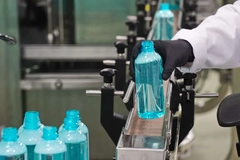Aluminum beverage bottles better in insulating ability than glass- study

The liquid content of aluminum bottles stays slightly colder than the liquid content of glass bottles when allowed to warm to room temperature.
01/02/06 According to the findings of a study conducted by undergraduate engineering science students at Loyola College in Maryland, the liquid content of aluminum bottles stays slightly colder than the liquid content of glass bottles when allowed to warm to room temperature.
Why is "slightly colder" such a big deal? Because aluminum is normally thought of as a good conductor while glass as an insulator. In fact, the thermal conductivity of aluminum is over 100 times greater than that of glass.
In an unrelated study commissioned in 2004 by The Absolut Spirits Company, in association with its aluminum-bottled Danzka brand hitting the market, aluminum bottles were found to chill faster.
This latest study implies that aluminum bottles defy logic and essentially behave like glass when it comes to keeping beverages cold.
The study itself was performed by five students as part of the laboratory requirement for their junior experimental methods course. Natasha Epps, Caitlin Hogan, Amanda Levinson, Tom Scida and David Wright worked with commercially available bottles of identical content capacity: one impact-extruded aluminum bottle supplied by CCL Container, and the other an amber soda-lime glass bottle.
The identical thermocouples used to measure temperature change over time were calibrated using an ice-water bath. Both bottles were filled with 355mm (12 oz.) of water and cooled overnight to about 6 degrees Centigrade. The thermocouples were suspended at the same depth in the radial center of each bottle.
About two and one-half hours later, the water in the glass bottle registered the study's end point of 20.9 degrees Centigrade versus 22.2 degrees Centigrade for the water in the aluminum bottle. However while the aluminum bottle gives measurably better insulating performance, the difference is so small that the responses are the same within measurement uncertainty.











